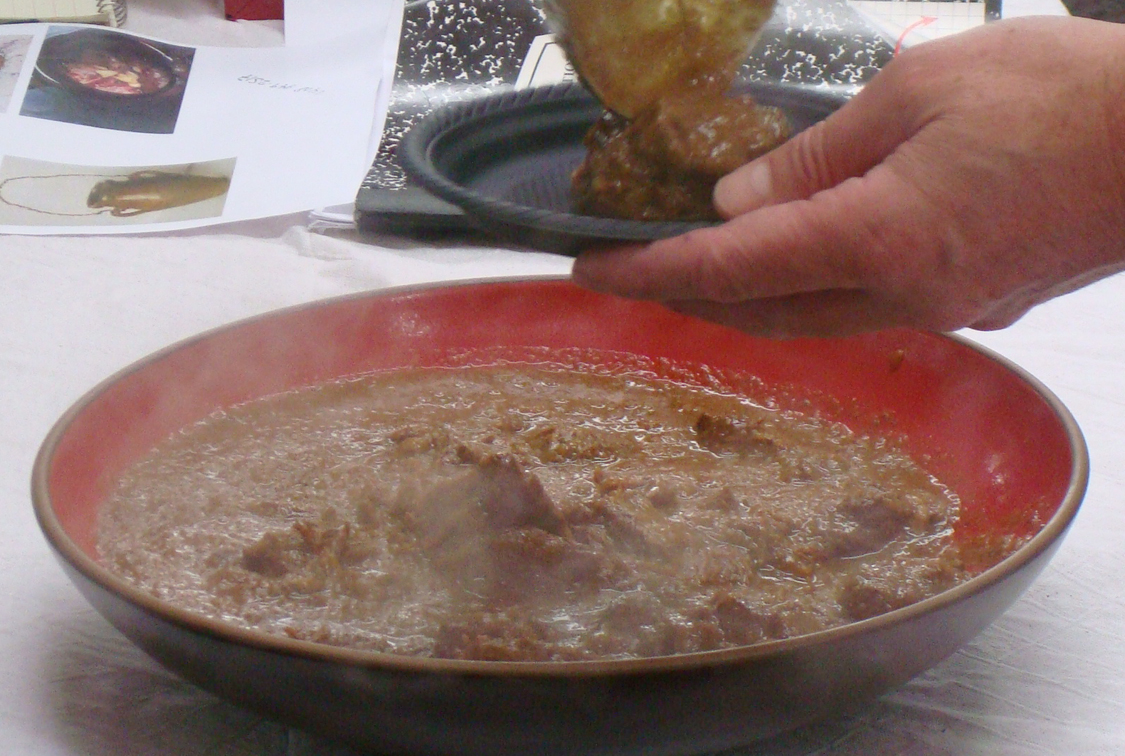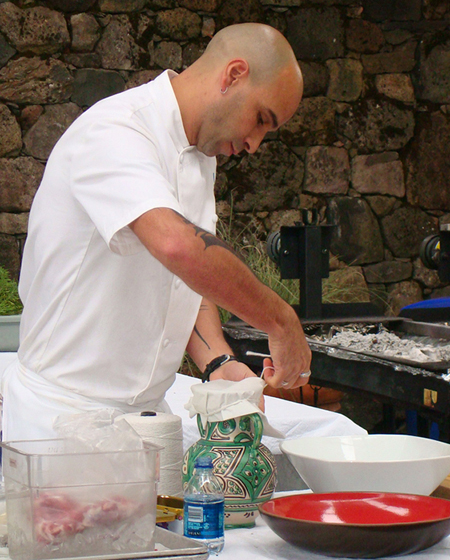Playing With Fire
It was a brisk morning in St. Helena, but troughs of burning, glowing coals provided warmth as we gathered together, our appetites already primed for the charred, long-simmered delights yet to come.
We were there to watch three Mediterranean culinary stars demonstrate the ancient art of cooking over fire: Mourad Lahlou, the Marrakech-born chef-owner of Aziza in San Francisco; esteemed cookbook author Paula Wolfert; and Haouari Abderrazak, chef-owner of Haouari Restaurant on the island of Djerba, Tunisia.
It was all part of the recent “Worlds of Flavor International Conference” at the Culinary Institute of America’s Greystone Campus. This year’s theme was: “A Mediterranean Flavor Odyssey.”

Shrimp and fish brochettes sizzled on a grill, as Abderrazak mixed up a boldly flavored red sauce of tomatoes, olive oil, lemon juice, and harissa (a blend of chiles, cumin, coriander, and caraway) to accompany them.
Lahlou planned to make lamb tangia — chunks of lamb shoulder simmered for 12 hours with saffron, garlic, preserved lemons, and ras el hanout (a Moroccan spice blend that can contain about 50 ingredients, such as ginger, anise, cinnamon, nutmeg, cardamom, turmeric, and dried flowers).

It is made in a tanjia, a clay vessel that is sealed with wax paper, then buried in hot coals or wood ash to cook.
Wolfert advised that it’s best to use an unglazed vessel, so that the flavors of the earth come through more. Asian supermarkets, she added, are great places to find unglazed clay pots of all shapes and sizes. When cooking with a clay pot, just be sure to never put one that’s cold on something hot, or to put one that’s hot on something cold. You risk the pot cracking, if you do.
“If you cook the same dish in it and only that, over time it will give back those same flavors and add to the flavor of the food,” she said.
Mourad added, “When pots get older, they are really guarded because of this, and passed down from generation to generation.”
He called this style of cooking slowly in ashes, “quintessential sous-vide.” “It’s the only dish in Morocco that you make at night,” he explained. “You bring the tagina to the Turkish baths at night, and you bury it in the ashes used to warm the baths. You come back the next day, and it’s done. The heat is constant.”
Into a beautiful jug-like vessel went lamb shoulder, smen (aged butter that tastes like bleu cheese), and spices. Another larger earthenware vessel nearby, which had been cooking in the ashes overnight, held the finished product.
It needs no stirring as it cooks. Ingredients are purposely layered so that the harder ones are on the bottom closest to the heat, and the softer ones are on top.
Even if you don’t have your own Turkish baths nearby, you can mimic the method of cooking by burying your clay vessel in hot ashes in a fireplace, pizza oven, or Weber grill.
As Lahlou poured the steamy, tender, saucy lamb from the clay vessel into a serving dish, we gathered around for a taste. Fork-tender meat with sweet earthy flavors. What a grand, firey way to start a day.

Mourad Lahlou’s Lamb Tanjia
(Chefs being chefs, this recipe is measured in grams)
6 grams cumin seeds
1 gram toasted saffron
3 grams ras el hanout
1,500 grams of boneless, trimmed lamb shoulder, cut into 3-inch chunks
40 grams peeled garlic cloves
1 1/2 quartered preserved lemons
70 grams smen (aged butter) or ghee or salted butter
250 ml water
Combine and toast spices. Grind with mortar and pestle. Rub spice mixture onto meat.
Place meat in a tanjia, adding rest of ingredients. Seal tangia with six layers of wax paper, secured with butcher’s twine. Bury tangia in hot coal or wood ashes for a minimum of 12 hours. Serve hot.
Haouari Abderrazak’s Fish Brochettes
3 tablespoons olive oil
Juice of 2 lemons
Juice of 2 limes
2 garlic cloves, minced
Salt and pepper, to taste
Cumin, to taste
Paprika, to taste
2 pounds fish fillets, cubed
16 large shrimp, cleaned and peeled
Make a marinade by combining olive oil, lemon juice, lime juice, garlic, salt, pepper, cumin and paprika. Toss fish and shrimp with this mixture, and allow to marinate for two hours in the refrigerator.
Thread fish and shrimp on skewers. Grill brochettes quickly, turning them as needed. Serve sauce kerkenaise on the side.
Haouari Abderrazak’s Sauce Kerkenaise
3 tomatoes, peeled, seeded and crushed
Hot peppers, diced, to taste
2 1/2 cloves garlic, crushed
1 tablespoon harissa
3 tablespoons olive oil
Lemon juice
Salt and pepper
Mix everything together, and place in a serving bowl.


The lamb sounds amazing, but I don’t know if I have the patience to wait 12 hours while it cooks.
All good things come to those who wait, Nate. Hah! Plus, just think: You can enjoy a long siesta while the ashes do all the cooking for you.
Pingback: Oyster Food and Culture » Blog Archive » Paprika beyond Hungary and Spain
Thanks Carolyn for reporting on the proceedings for those of us who couldn’t attend.
The Shrimp and fish brochettes sizzled on a grill sounds scrumptious! We prepared Shrimp Tequila over the grill last Sunday – it was a big hit with friends and family…
Pingback: Food Gal » Blog Archiv » Moroccan Magic At Aziza in San Francisco